Our Class A RV lost a tire at 65 mph! Can you avoid a flat tire or blowout on your RV?
If you are in Florida in your RV during hurricane season you need to be able to move your RV quickly if a storm threatens. This past season, a hurricane was headed directly toward us and we needed to evacuate.
As we drove north on the turnpike out of the storm’s way, the unexpected happened- a flat tire in the middle of an evacuation! Here’s what we did and what we learned, and hopefully our experience will help you.
How can you avoid a flat tire or blowout on your RV?
Yes, you can prevent or at least lessen the chances of having a flat tire or blowout on your RV by not overloading it, having your tires properly inflated, and continuously monitoring your tires’ inflation pressure and temperature with an RV tire pressure monitoring system.
RV Tire Safety
When we bought our 43-foot Newmar Class A, we knew that with an RV this large there was much more we needed to learn. In addition to air suspension and a diesel engine, this is a much heavier tag axle rig (three axles and eight tires) and learning about the tires was a priority. We all know that you should inspect your tires and check the tire pressure before every RV trip, but we wondered if there were other ways to increase our RV tire life.
RV tires are one of the very first, and most important things to learn about to avoid injury (or even death) in the event of a tire blowout. Read on to learn more about why each item is important to ensure safety during RV road trips.
Why you should weigh your Class A RV
It’s very important to get your RV weighed to make sure you don’t overload the weight capacity of your tires. The Recreational Vehicle Safety Education Foundation said that almost 25% of the RVs they weighed had loads that exceeded the capacity of the tires! They said on average, the RVs were overloaded by over 900 pounds based on manufacturer specifications.
Bridgestone / Firestone conducted a different survey and learned that 4 out of 5 RVs had at least one under-inflated tire, a third of which were dangerously under-inflated and at risk of failure. An under-inflated tire can’t carry the load a properly inflated tire can and the extra weight on an under-inflated tire causes greater heat buildup in the tire, which can lead to tire failure. Firestone found that 40% of all rear tires were overloaded. The improper weight distribution resulted in 28% of all motor homes being out of balance by 400 pounds or more from one axle to the other.
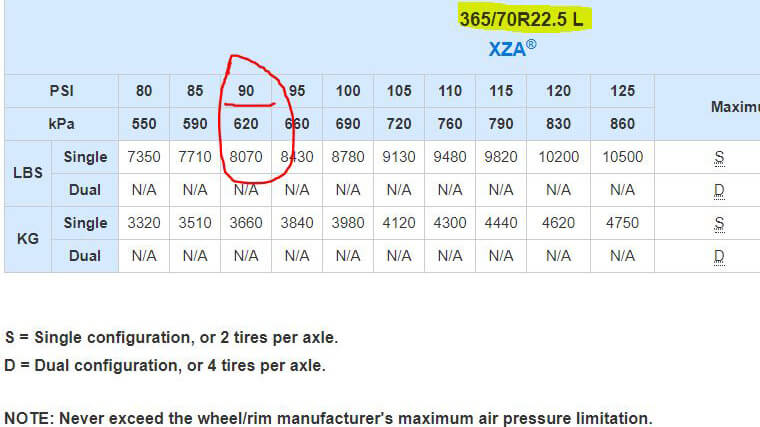
It’s no surprise that with all of the amenities, storage space and multiple slides in today’s luxury Class A big rigs, it can be easy to overload an RV and never realize it. Most people don’t even know that they should weigh their RV, but overloaded RVs on incorrectly inflated tires can be extremely dangerous!
Insider Tip: If your RV is overloaded and exceeds the tire manufacturer weight limits, you may be found at fault in an accident even if it’s not your fault!
How much weight can your RV carry?
There is no single answer to how much weight your RV can carry. All manufacturers are required by federal law to provide weight ratings based on all the various RV components. The suspension system, wheels, tires, axles, brakes, and the RV itself all have weight ratings based on the lowest capacity of the components. Exceeding an RV component weight rating overloads the component and may make it wear out prematurely or completely fail. Your RV tires are generally the most susceptible component to overload and therefore one of the most frequent to fail!
Find Your RV data plate to find out how much it is rated to carry
A federal data plate is required by law on all vehicles. It lists the Gross Vehicle Weight Rating and the Gross Axle Weight Rating for the vehicle.
The Gross Vehicle Weight Rating or GVWR is one of the most crucial safety factors for your RV. The Gross Vehicle Weight Rating (GVWR) is the maximum allowable weight of the vehicle when fully loaded for travel including all passengers, all cargo, fluids, and aftermarket accessories. You must not exceed the total GVWR for your vehicle.
The Gross Axle Weight Rating or GAWR is the maximum weight that should ever be placed on a given axle. The GAWR divided by two is the maximum axle rating for each end of the axle. You must not exceed this weight on either end of the axle, even if the total doesn’t exceed the GAWR.
In addition to the federal data plate, all members of the Recreation Vehicle Industry Association (RVIA) are required to have an additional label on the vehicles they manufacture. This label lists additional information not available on the federal data plate and supersedes the federal data plate.
Weight terms on the RV weight labels are:
- GVWR– Gross Vehicle Weight Rating: The maximum permissible weight of the motorhome.
- UVW– Unloaded Vehicle Weight or Dry Weight: The actual weight of the RV as built at the factory, with full fuel, engine oil, and coolants, excluding passengers, cargo, freshwater, LP gas, or aftermarket accessories.
- CCC– Cargo Carrying Capacity: is the maximum permissible weight of personal belongings that can be added. CCC is equal to GVWR minus UVW and full propane weight.
- GCWR– Gross Combined Weight Rating: The maximum allowable loaded weight of the motorhome and any towed trailer or vehicle.
If you want to learn more details, Michelin produced the video below, and while a little dated, still has some good information:
How do you weigh your RV?
Ok, now that you understand how important it is to know how much weight your RV can carry, let me show you how easy it is to get your RV weighed!
First, there’s an app for that! There are actually 2 apps that you want. Download the free CAT Scale app which helps you find CAT scales near you. The second free app that you want is called Weigh My Truck by CAT Scale, this one allows you to weigh and pay directly through the app! You must set up an account to do this, but using the app makes it much faster to get through the process and it sends you an email showing your certified weights when you are done.
Once you have an account set up, find the location of a CAT Scale on the CAT Scale app. Drive your RV to the Scale. Pull onto the scale making sure that your front wheels are on one pad (pads are outlined by yellow lines) and your rear wheels are on another. If you have a tag axle (or third axle), make sure both your tag and rear axle are on the same pad.
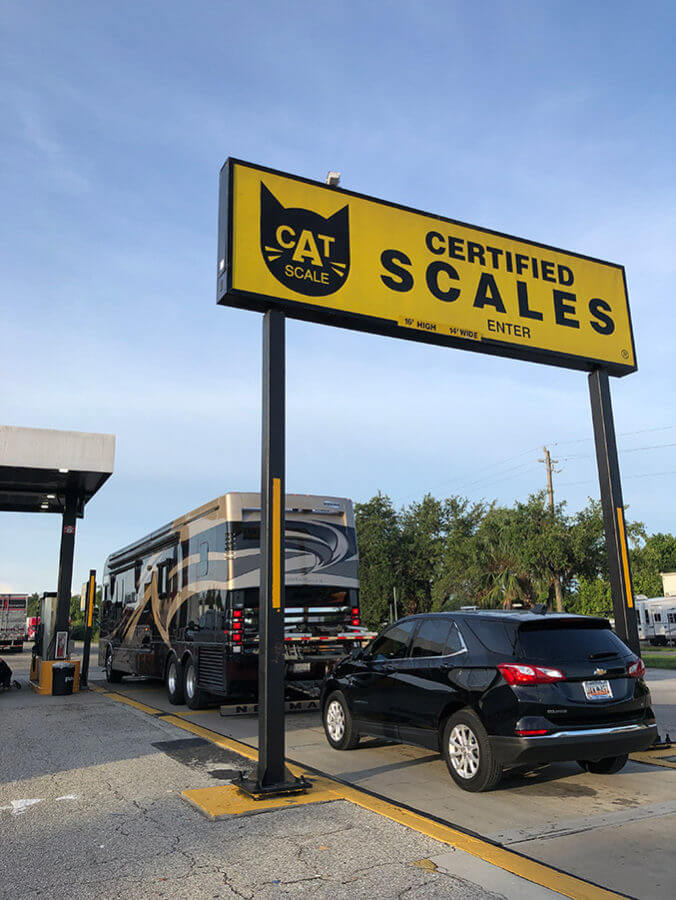
Enter the location number for the scale (found next to the intercom) into the Weigh My Truck app. Your profile will come up on your smartphone, verify the information is correct, and hit accept. It will show you the fee and once you accept the fee, the scales will calculate your front and rear wheel weights and show it on your smartphone. Once you hit done, you will receive an email with your certified weights. If you need a hard copy, there will be one inside that you can get from the weigh-master. Here is what ours looked like.
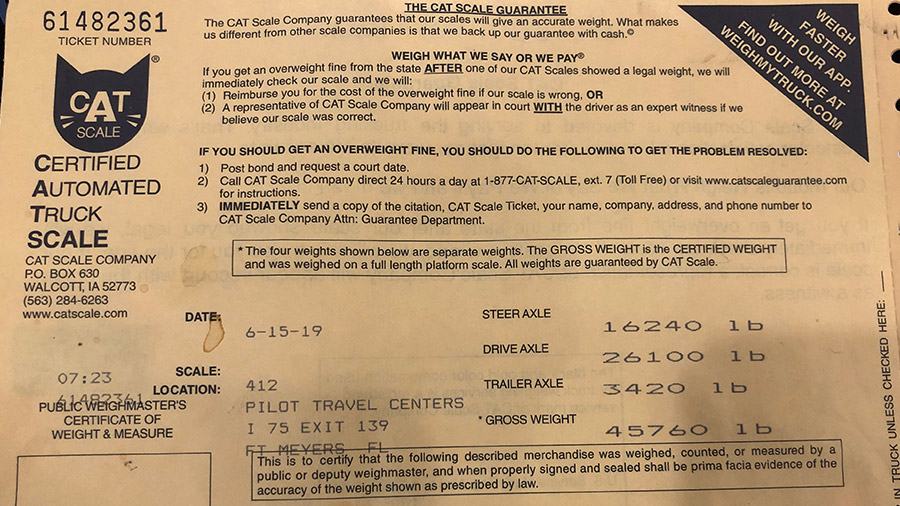
It’s fast and easy and you don’t have to try to talk to anyone on the weigh station intercom or stand in line to pay. You don’t even need to get out of your RV!
Tip: Make sure your RV is fully loaded with everything you will be carrying including all passengers, cargo, food, clothing, fuel, water, and propane. Water, fuel, and propane alone can exceed 750 pounds!
Do you need to weigh your tow vehicle?
No, you don’t need to weigh your tow vehicle. You are weighing your RV to find out what your fully loaded Gross Axle Weight is for each axle so that you can find out what your RV tire pressure should be based on manufacturers’ recommendations.
You do need to know the weight of your tow vehicle (found in your owner’s manual) to make sure you don’t exceed your RVs’ Gross Vehicle Weight Rating (GVWR).
What to do if a tire blows out in your RV
How your RV will respond when you lose a tire depends on which tire goes flat or blows out. If a front tire on your RV has a blowout, it can be very dangerous if you do not react correctly!
Do you know what to do if you have a front tire blowout? Should you take your foot off the accelerator or step on the brakes? The surprising answer is no, you should actually SPEED UP if your front tire has a blowout to regain control during your forward momentum!
How to Handle an RV Front Tire Blowout
Michelin and the RV Association produced the video below showing exactly how to react and what to do if your RV has a front tire blowout. It’s pretty interesting considering I would have thought to do the exact opposite!
How Tire Safety Bands Can Help Save Your Life During a Blowout
When we replaced our RV front tires, we learned about Tyron safety bands. These simple yet extremely effective safety add-ons are designed to help you maintain steering and traction control during a front tire blowout. When we learned that most emergency response vehicles have Tyron safety bands installed, we decided to have them installed.
How do Tyron Tire Safety Bands Work?
When you have a tire blowout, the tire deflates and there is no air pressure to hold the tire in place on the wheel. The flapping tire can cause loss of steering control and serious body damage to your RV. The Tyron band is installed in the rims well and provides support to a deflated tire so the bead doesn’t slip into the well. The tire support provides better steering and braking control.
Here’s a picture from Tyron’s website that helped convince us they were worth the investment:
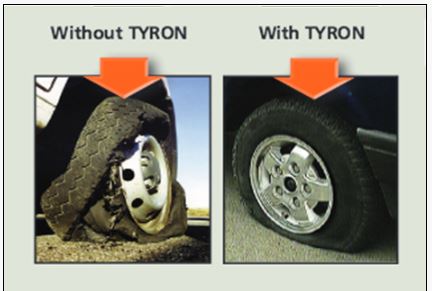
How much do Tyron Safety Bands Cost?
We had our Tyron Bands installed at North Trail RV in Fort Myers, Florida and it cost us $2,600. We have seen plenty of RV crashes and heard stories from others that have had a front tire blowout happen, so this seems like a reasonable investment to help protect us and our RV.
If you want to learn more about them, here’s the link to the Tyron USA website.
What happens if a rear tire goes flat on your RV?
If it is a rear tire that goes flat on your RV, as it was in our case, you might not even realize it. Since it was a rear tire, we probably would never have known that we lost a tire if our RV Tire Pressure Monitoring System did not alarm us! Our RV didn’t ride differently, and it was easy to drive to a safe place to pull over.
We have the EEZRV RV Tire Pressure Monitoring System on all of our RV tires and tow vehicle tires and highly recommend it. We use it every time we travel. It not only monitors tire pressure but tire temperature too which can be just as important. A defective or improperly inflated tire can overheat and catch fire, igniting your tow car in flames- imagining towing a flaming car down the highway behind your RV!
A Tire Pressure Monitoring System (TPMS) is one of the most important, inexpensive, and best pieces of safety equipment you can buy. Don’t travel without one!
Do Class A Motorhomes have spare tires?
Since this was our first flat tire in our RV, I never even thought to ask- do Class A RVs have spare tires? And I quickly learned that no, Class A motorhomes do not carry spare tires. Class A RV tires are really large, like semi-truck big, and these big rig tires can weigh almost 100 pounds each!
There just isn’t room to store a spare tire on a big rig, and if there were, you would still need a heavy-duty hydraulic jack to raise the motorhome. Changing a Class A RV tire yourself is not practical. Next step- call Roadside Assistance!
Do You Have Roadside Assistance for your RV?
When we purchased insurance for our RV, we were told that it came with Roadside Assistance. Our first call when our tire went flat was to our insurance agent who gave us the number to our carrier’s roadside assistance hotline. We contacted them and learned that while we did have roadside assistance, the assistance that the policy provides will only tow our motorhome to a repair facility- not any mobile tire repair. The only way to get help with our flat tire was to find a local mobile mechanic and pay for it ourselves!
Since we weren’t yet far from home, we were able to use a local mobile tire repair company that a friend referred us to. They came out within 30 minutes and, lucky for us, they were able to repair our tire and get us back on the road.
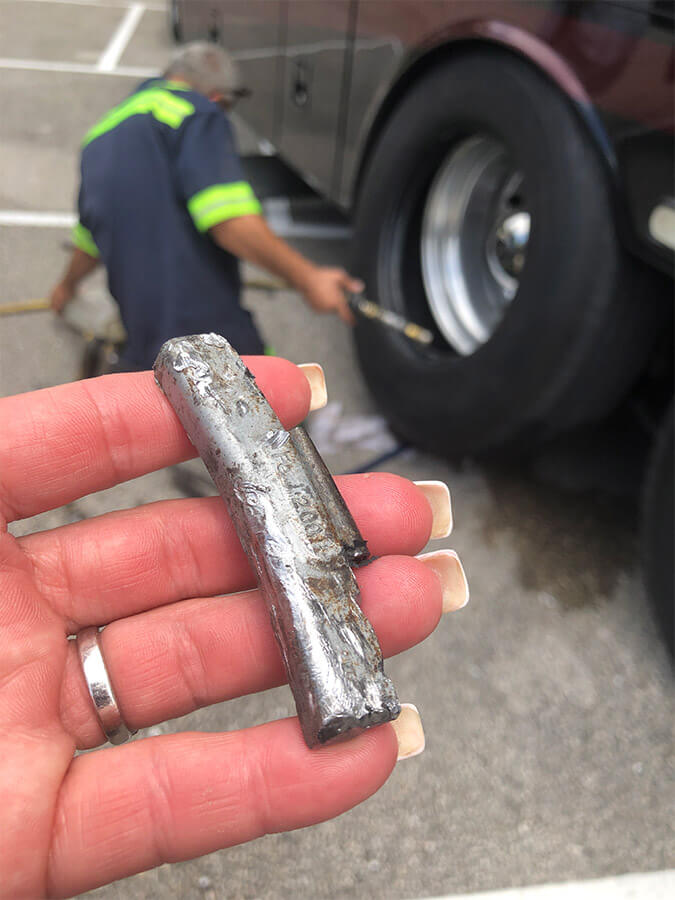
This is what was in our tire. It is a tire balancing weight from another car that we happened to hit at just the right angle.
The big lesson that we learned at the worst possible time- during a hurricane evacuation, is to know exactly what your policies and memberships do and do not cover!
Does your Roadside Assistance provide Mobile Repairs- Specifically Tire Coverage?
We learned the hard way that our RV insurance policy does not cover mobile tire repair, but we thought that our membership in the Good Sam Club would, or at least reimburse us for the repair. Again, we were wrong! That is an add-on to your Good Sam Club Membership and since I thought we were covered by our insurance policy’s roadside assistance, I never purchased the add-on!
Now that I realized that we needed more coverage for our RV if we didn’t want to get stuck with being towed to a repair facility to wait for repairs, it was time to investigate the various RV Roadside Assistance Plans.
I also wanted to make sure that the Roadside Assistance program that we picked could accommodate Class A Big Rigs. As we have learned in the past, many companies say they work with RVs but many cannot service large luxury Class A motor coaches.
I wrote a post about how to choose a Roadside Assistance program and a review of what services each of them provides.
Comparison of RV Roadside Assistance Programs!
RV Tire Safety Recap
With a minimal amount of effort, you can reduce your chances of experiencing a blowout in your RV tireS and increase your safety level.
- Regularly inspect your RV tires
- Monitor your tire pressure and temperature using a Tire Pressure Monitoring System
- Know your RV weight limit capacity and don’t overload it
- Install Tyron Safety bands on your front tires to improve your control during a blowout
Review your protection coverages and consider adding an additional Roadside Assistance program with mobile tire protection services.
Related Questions People Ask
Do Class A RVs Have to Stop at Weigh Stations?
The short answer to this is no. Most of the time you won’t need to stop at a weigh station. There are states that will randomly direct you to a weigh station from time to time. But most of the time you’re safe to roll on by.
Do Class A Motorhomes Have Airbags?
Class A Motorhomes will have seatbelts but because they are not required to meet crash standards, it is rare to find one with airbags.
Do Class A RVs have Seatbelts?
Yes, Class A motorhomes have seatbelts in the forward cockpit area that meet federal safety standards. RVs will occasionally have seatbelts on some of the passenger seating in the main cabin.
